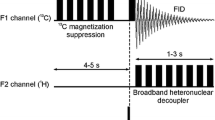Summary
The effect of the substitution pattern on the kinetics of the Type II (O2(1Δg)-mediated) dye-sensitized photooxidation of a series of nine tyrosine derivatives was investigated. Overall (kt) and reactive (kr) rate constants for the interaction of the excited oxygen species with the amino acid derivatives were determined. A parallel study on solvent and pH effects was carried out.
The presence of different substituents in nuclear positions or in the amino acid side chain greatly affect the photooxidation rates.
An upper limit for photooxidation quantum yield, calculated from the kinetic data, varies from 0.03 to 0.25, being the higher for halogenated tyrosines and the lower for esterified tyrosines and for the nitro-derivative.
The variation of solvent polarity and pH of the reaction medium confirm that the presence of the ionized phenolate group in tyrosine, clearly dominates the quenching process. As already postulated for generic phenolic derivatives, it proceeds through a polar intermediate complex which posses some component of charge-transfer character.
Esterification of the carboxilic acid of tyrosine selectively decreases the contribution of the reactive step to the overall process of O2(1Δg) quenching. An amide group in the same position does not produce noticiable changes in this sense. The presence of a highly deactivating nitro group in nuclear positions greatly diminishes the magnitude of both overall and reactive interactions.
For all three, o-, m- and p-tyrosine the values of photooxidation quantum yields show an excellent parallelism with the rates of consumption of the — NH2 group of the amino acid chain, upon sensitized irradiation. It could react, in the cases of 0- and m-tyrosine in a secondary, non photochemical, step.
Similar content being viewed by others
Abbreviations
- O 2(3Σ −g ):
-
ground state triplet oxygen
- O 2(1Δg):
-
singlet molecular oxygen
- Tyr:
-
L tyrosine
- TyrD:
-
tyrosine derivatives
- Eos:
-
eosine
- RB:
-
rose bengal
- FFA:
-
furfuryl alcohol
- DMA:
-
9, 10-dimethyl anthracene
References
Benassi CA, Scoffone E, Galiazzo G, Jori G (1967) Proflavine sensitized photooxidation of tryptophan and related dipeptides. Photochem Photobiol 6: 857–866
Bertolotti S G, García NA, Arguello GA (1991) Effect of the peptide bond on the singlet-molecular-oxygen-mediated sensitized photooxidation of tyrosine and tryptophan dipeptides. A kinetic study. J Photochem Photobiol B: Biol 10: 57–70
Endo K, Seya K, Hikino H (1988) Photo-oxidation of L-tyrosine an efficient 1, 4-chiriality transfer reaction. J Chem Soc Chem Commun: 934–935
Foote CS, Y-Ching T (1975) Chemistry of singlet oxygen XXI. Kinetics of bilirubin photooxygenation. J Am Chem Soc 97: 6209–6214
García NA (1992) Environmental significance of singlet molecular oxygen-mediated degradation of aquatic phenolic pollutants. J Photochem Photobiol B: Biol 14: 381–383
García NA (1994) Singlet molecular oxygen-mediated photodegradation of aquatic phenolic pollutants. A kinetic and mechanistic overview. J Photochem Photobiol 22: 185–196
Gsponer HE, Previtali CM, García NA (1987) Evidence for pysical quenching of singlet oxygen (O2(1Δg)) by dinitrophenols. J Photochem 36: 247–253
Hagg WR, Hoigné J (1986) Singlet oxygen in surface waters. 3. Phothochemical formation and steady-state concentrations in various types of waters. Environ Sci Technol 20: 341–348
Jori G (1975) Photosensitized reactions of amino acids and proteins. Photochem Photobiol 21: 463–467
Lindig BA, Rodgers MAJ (1981) Rate parameters for the quenching of singlet oxygen by water-soluble and lipid-soluble substrates in aqueous and micellar systems. Photochem Photobiol 33: 627–634
Mártire DO, Braslavsky SE, García NA (1991) Sensitized photooxidation of dihydroxybenzenes and chlorinated derivatives. A kinetic study. J Photochem Photobiol A: Chem 61: 113–124
Michaeli A, Feitelson J (1994) Reactivity of singlet oxygen toward amino acids and peptides. Photochem Photobiol 59: 284–289
Miskoski S, García, NA (1989) Effect of chlorophenolic pesticides on the photochemistry of riboflavin. Toxicol Environ Chem 25: 33–43
Miskoski S, García NA (1991) Dark and photoinduced interactions between riboflavin and indole auxins. Collect Czech Chem Commun 56: 1838–1849
Miskoski S, García NA (1993a) Influence of the peptide bond on the singlet molecular oxygen-mediated [O2(1Δg)] photooxidation of histidine and methionine dipeptides. A kinetic study. Photochem Photobiol 10: 447–452
Miskoski S, Bertolotti SG, García NA, Arguello GA (1993b) On the O2(1Δg)-mediated photooxidative behaviour of tripeptide glycyl-tyrosyl-alanine in alkaline medium. A kinetic study. Amino Acids 4: 101–110
Moan J (1986) Porphyrin photosensitization and phototerapy. Photochem Photobiol 43: 681–690
Murov SL (1973) Handbook of photochemistry, chapt 9. M Dekker, New York, p 89
Rizzuto F, Spikes JD (1977) The eosin-sensitized photooxidation of substituted phenylalanines and tyrosines. Photochem Photobiol 25: 465–476
Rizzuto F, Spikes JD, Coker GD (1986) The lumiflavin-sensitized photooxidation of substituted phenylalanines and tyrosines. Photobiochem Photobiophys 10: 149–162
Rodgers MAJ, Snowden PT (1982) Lifetime of O2(1Δg) in liquid water as determined by time-resolved infrared luminescence measurements. J Am Chem Soc 104: 5541–5543
Spikes JD, MacKnight ML (1970) Dye-sensitized photooxidation of proteins. Ann N Y Acad Sci 171: 149–162
Straight RC, Spikes JD (1985) Photosensitized oxidation of biomolecules. In: Frimer AA (ed) Singlet oxygen, vol IV. CRC Press, Boca Ratón, pp 91–143
Straight RC, Spikes JD (1978) Sensitized photooxidation of amino acids. Effect on the reactivity of their primary amine groups with fluorescamine and o-phtalaldehyde. Photochem Photobiol 27: 565–569
Tratnyek PG, Hoigné J (1991) Oxidation of substituted phenols in the environment: A QSAR analysis of rate constant for reaction with with singlet oxygen. Environ Sci Technol 25: 1596–1604
Weil L (1965) On the mechanism of photooxidation of amino acids sensitized by methylene blue. Arch Biophys 110: 57–68
Wilkinson F, Brummer JG (1981) Rate constants for the decay and reactions of the lowest electronically excited state of molecular oxygen in solution. J Phys Chem Ref Data 10: 809–1000
Author information
Authors and Affiliations
Rights and permissions
About this article
Cite this article
Criado, S., Soltermann, A.T. & García, N.A. Influence of the nuclear and extranuclear substitution on the singlet molecular oxygen [O 2(1Δg)]-mediated photooxidation of tyrosine derivatives: A kinetic study. Amino Acids 8, 367–377 (1995). https://doi.org/10.1007/BF00806554
Received:
Accepted:
Issue Date:
DOI: https://doi.org/10.1007/BF00806554




